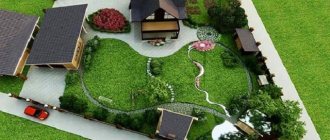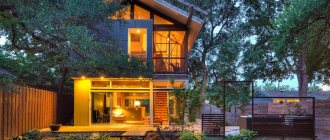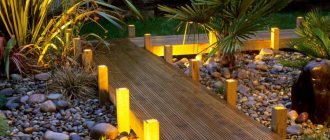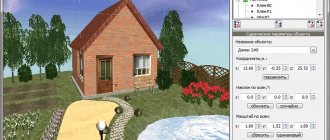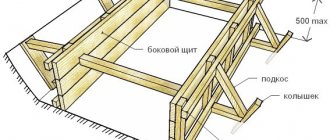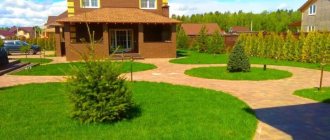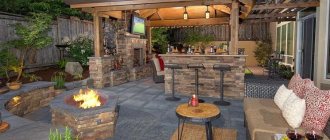No. 1. Basic requirements for site lighting
When organizing a lighting system, it is necessary to take into account a lot of nuances so that the area is safe at night and does not lose its aesthetic qualities. The main requirements for lighting of dacha and suburban areas are as follows:
- the electrical wiring should be non-hazardous, and it is better to include an RCD and a circuit breaker in the circuit;
- lighting control should be convenient;
- all lighting elements, including light bulbs, lamps, switches, must be designed for outdoor use and protected from moisture and dust. The cable is laid in a pipe or protective corrugation;
- It is necessary to highlight all parts of the territory; ideally, the boundaries of the site should be normally visible in the dark;
- It is better to use energy-saving lamps, especially if the outdoor lighting will be turned on every day;
- There must be a lighting diagram for the area, and it is advisable to draw it up before starting landscaping work, so as not to destroy the finished elements later when laying cables.
No. 2. Drawing up a lighting plan for the area
The variety of garden lamps on sale makes your eyes widen. I would like to use literally everything on my site: decorative lanterns, illuminated garden figures, lamps with moonlight, colored lanterns for decorating tree crowns, garlands, and other lighting fixtures that sometimes surprise you with their unusual design. In order to prevent chaos in the summer cottage, it is necessary to think in advance about the main locations of the lamps, determine the functions assigned to the lighting and choose the style of the lighting fixtures.
At this stage, it is necessary to draw up a plan diagram of the location of all lamps on the site. To do this, you can use a photocopy of the territory map or draw a scale plan indicating all existing buildings. It is important to create a lighting plan in parallel with thinking through the remaining elements of landscape design. The locations of future lamps are determined along with the design of gazebos, garden paths, ponds, patios, terraces and other recreation areas. Otherwise, the risk of having to rework some of these elements due to the need to run power cables is exceeded.
On the diagram it is necessary to note where the lamps will be located, how many there will be, and what function will be assigned to them; you can also indicate the size and style of execution. Now an electrical connection diagram : for those who have at least a little knowledge of electrical engineering, this is an easy task. It is better to entrust the installation of the entire lighting system to specialists, since, first of all, it should be as safe as possible for the owners of the site.
When drawing up a lighting plan, you must remember that it is necessary to highlight the entrance to the house , the gate or gate, the perimeter of the site, as well as the most dangerous places on the territory, incl. steps and bridges. It is not recommended to illuminate the house from the fence, as this creates a blinding effect. When preparing a lighting scheme, it is important not to forget about the climatic characteristics of the region. For example, the height of the lamps should be such that they perform their functions under the maximum possible layer of snow.
What to consider when planning external lighting for your dacha
In order to install street lighting in a summer cottage at night, you need not only to choose lanterns, but also to take care of drawing up a plan for the placement of support pillars throughout the entire territory.
You also need to outline the directions for laying cables in the ground. The lighting zones and places for connecting electrical cables of each lighting device should be marked.
To do this, install water-protected sockets or switching boxes. The owner of the site will decide where the switches will be located, based on ease of use.
To apply the lighting scheme, you should use a copy of the layout of your site. If it is not there, you need to make a plan with a scale of 1:100 and place all the buildings on it.
The lighting scheme is arranged taking into account the planned landscape design. Seating areas and garden paths should also be placed.
No. 3. Types of site lighting
Lighting a suburban area performs several functions at once, and for each of them it is better to provide a separate type of lamps.
Main types of garden lighting:
- general or functional lighting is necessary for safe movement around the territory after dark, for performing certain work and for proper rest in the evening. General lighting fixtures are primarily installed at the entrance to the site, in parking lots, and near the entrance to the house. They are also necessary for lighting garden paths and recreation areas;
- marking of site elements - This is a special case of general lighting. The main function of the marking light is to indicate certain objects, for example, the boundaries of a parking lot, the location of gates, steps, etc. In this case, you can use small lamps and even “luminous” stones;
- automatic lighting systems that increase the safety of the territory. Thanks to the presence of time relays or motion sensors, one or more lighting elements can be turned on when it gets dark or when intruders appear at the dacha. Such elements can also be used to scare away animals and birds by creating the effect of presence;
- decorative lighting. This includes lamps that are designed to decorate and draw attention to interesting elements of the landscape rather than provide full-fledged light. Alpine slides, ponds, tree crowns, and recreation areas are equipped with such lighting, and LED strips, flashlights, garden figures with built-in lamps, lamps that can shine in different colors, and other elements are used for this.
Watch the video: Lighting a summer cottage - how to organize
Lanterns or mast lamps will fit perfectly into the design of your garden when they illuminate alleys, lawns near a house or pond, or a fountain in a circle. Such a path will look very attractive from the outside when small lanterns illuminate it on both sides. They can be either 50 cm or 150 cm high. Lighting of a suburban area photo:
- Where to order luxury curtains with delivery?
Mobile racks: modern warehouse storage systems
Aerosol particles as air pollutants in the suburbs. How to protect yourself?
Regarding sidewalk lighting, this type of lighting is used for orientation in the garden. Such lamps are placed in places where bright light is not required. Recently, it has become very common to install such sidewalk lamps directly into a stone slab, which is the road surface, although they can already be classified as recessed lamps.
The switching on of such lamps, both sidewalk and mast, can be done either independently, that is, manually, or automatically, using a control panel or a computer program. In addition, such light in the garden can be turned on using a regular switch. To use automatic light switching, it is important to install touch sensors that will turn the lighting on and off, reacting to your appearance in the garden and movement. Lighting of a summer cottage - see photo:
No. 4. Features of functional site lighting
The tasks of functional lighting are simple and clear. If decorative lighting cannot be used in every summer cottage, then it is impossible to do without general lighting. When highlighting all important elements in order to increase the safety of movement around the territory, it is worth remembering that the emphasis in lighting must be placed on gazebos, patios, houses and other buildings - garden paths should not be flooded with too bright light, otherwise those walking along them will experience great discomfort. The most illuminated place on the site is the facade of the house and the porch: it will be more comfortable to move from less illuminated areas to brighter ones. It is important that even in the dead of night, functional lighting allows you to see the boundaries of the site .
It is also necessary to highlight stairs, curbs, bridges and other most dangerous objects. Lamps must be spaced evenly along paths. Lanterns, floor lamps with frosted glass diffusers, bright spotlights, spherical lamps and other elements can serve as light sources.
No. 5. Decorative lighting
Decorative lighting is necessary for recreation areas and objects that you want to admire even after dark. Typically, additional lighting is provided for flower beds, trees, shrubs, fountains, ponds, alpine slides, garden sculptures , as well as gazebos, patios and benches. Decorative lighting complements the main lighting and provides dim light, creating a romantic and slightly mysterious atmosphere. There are a lot of ways to organize it - it all depends on the style of the site and the imagination of the owner.
In order not to make a mistake when choosing the style of lamps for your site, you can use a simple rule. The more elaborate and diverse the landscape design of the garden, the more simple and concise the lighting items should be. If the style of the site is close to minimalism, then you can use lamps of the most bizarre and non-standard shapes, placing the emphasis on them in decorating the garden.
Decorative lighting in the garden
Devices for providing lighting can be very diverse, because with their help you can beat any design and create an excellent decor. Lighting technology perfectly decorates any garden. After all, it is known that in garden lighting there is such a thing as decorative lighting. Decorative lighting for each individual garden is a great opportunity to realize any fantasy. It is there that you can show your talent in the design art of decorative lighting for a summer cottage. Where else, if not at home, can it still be manifested?
In this type of lighting, you can use a variety of types of lighting and forms of lighting devices, from the most ordinary spotlights to garlands with LEDs. After all, it is decorative landscape lighting of the site that will help create that unique beauty, mystery and mystery that almost all owners of country houses strive for.
No. 6. Main types of lamps for the site
It is desirable that the illumination of the area is not only a stylish and functional addition, but also does not lead to exorbitant costs for the use of electricity. Traditional incandescent lamps are far from the most economical option ; they get very hot during operation, which consumes most of the energy, quickly burn out, and can even explode at low temperatures. There are a lot of alternatives to incandescent lamps today:
- fluorescent and halogen lamps , which are more economical and durable;
- LED lamps and strips do not heat up, consume minimal energy, shine quite brightly, and in terms of durability they confidently outperform competitors. Moreover, when using this type of lamps, it will be possible to easily change the brightness of the lighting. Typically, LEDs are used to create decorative lighting, arranging hidden lighting for ponds, steps, benches, the facade of a house, or hiding them in the crown of trees or shrubs;
- fiber optic systems are a new word in the field of garden lighting. They can be used as sources of main or additional light, for architectural lighting and even for decorating pools and ponds. Such a system consists of a projector (light source for the optical fiber), an optical cable or fiber, a common input, threaded attachments and various terminal devices. It turns out that with just one generator it is possible to provide lighting to a large area. The main advantages of the system are ease of operation, durability, cost-effectiveness and the absence of requirements for waterproofing of lamps.
We should also highlight such interesting modern solutions for garden lighting as paving slabs with LEDs built into them and fluorescent tiles with the ability to accumulate solar energy during the daytime.
Country decorative home lighting
Why do owners want to have decorative lighting for the walls of their home?
Firstly, to highlight the features of the facade of the house. To do this, they use directed light on the walls of the building using various LED strips, yellow light lamps, they are fixed directly on the walls of the building.
Secondly, to protect your home. Then your house is flooded with bright lanterns, which are installed at a distance from the house. For this purpose, halogen lamps are used.
No. 7. Types of street lamps by installation location
The huge variety of lamps designed for illuminating suburban and summer cottages can be divided into several groups:
- floor lamps , which include lanterns of different heights;
- wall lanterns are used to illuminate the house or fences, they can be hung on the wall at any height;
- pendant lights include lanterns and string lights that can be hung from tree branches or gazebo ceilings;
- spotlights with a directional beam of light are installed, as a rule, at ground level and serve to illuminate those areas that need to be highlighted on the site (a house, a beautiful tree, a fountain, etc.);
- indirect lamps or lanterns with a reflector direct the luminous flux downwards, therefore they are used to illuminate garden paths and flower beds;
- fiber optic luminaires stand out as a separate group due to their unique properties and versatility of use.
Classification of lamps according to the method of their fastening
The type of installation of lamps plays an important role, which is why they are divided into several types, namely:
- Wall-mounted. Such lamps are capable of performing both decorative and protective functions and are installed on the wall of a private house or other structures on the site.
- Ground. It is not difficult to guess that such lights are installed in the ground or paths and are invisible at night until they are turned on. It is worth noting that this type of lamps plays not so much a practical as a decorative role.
- Floor lamps. Typically, such devices are spherical in shape and installed on a special leg along paths or near the entrance to the site.
- Mushroom-shaped models are lamps with a special closing cap that directs the flow of light downwards. They are usually used for decorative functions, highlighting the surrounding landscape.
No. 8. Types of lamps by light source
To understand how diverse and unusual the lighting of an area can be, you need to understand what types of lamps can be based on the light source:
- electric. Everything is clear here, everything written above applies specifically to electric lamps. They make up basis for area lighting, are the most functional and require preparatory work, which includes digging trenches and laying cables in plastic or corrugated tubes;
- solar powered lanterns – an original and very economical way to illuminate individual areas of the site. Such lamps can only be used as a supplement to electric lighting. During the day they accumulate energy from the sun, and at night they emit a soft, pleasant light. Installation is as simple as possible - the lamp is installed where additional lighting is required, no trenches are needed, and if necessary, it can be easily moved to another location. Such lamps can be of any size, shape and design, they are not cheap, but they will not use electricity. The battery will charge even in cloudy weather;
- objects painted with luminescent paint, is an original way to decorate your site and diversify its decorative lighting;
- open flame. Can be used to create a romantic atmosphere candles, enclosed in cute shades. Another option - kerosene lamps. This is a purely decorative source of lighting, which must be constantly monitored to avoid fire.
Mains powered or solar powered lanterns?
Gas-discharge, halogen, LED and incandescent lamps can be used as lamps for garden lighting. However, it is LED lamps that are especially popular, because they have an attractive appearance, long service life, high efficiency and minimal electrical energy consumption.
A more fashionable and modern solution is solar-powered lamps, which will reduce the cost of lighting and illumination of the garden. The autonomy of the lamps allows you not to monitor their operation, because they are charged during the daytime and glow at night. Another advantage of alternative lighting sources is the ability to abandon the cumbersome and costly installation of an electrical network.
Advantages of lamps powered by solar panels:
- Durability.
- Mobility.
- Easy to care for.
- Automation and complete autonomous operation.
No. 9. Automation of turning on and off country lamps
Even at the stage of drawing up a plan for the location of lamps on the site, it is worth considering how they will be turned on and off. It will be easy and even pleasant for someone to carry out a similar procedure on their own every day, but if the area is large, and you are in the countryside not only in good weather, then regularly turning the lighting on and off can turn into a real problem. The solution is to automate the lighting system, and there are several options for implementing this idea:
- control using a twilight relay , which will turn on the lighting when the sensor installed on the site “feels” the onset of twilight, and turn it off at dawn. The sensor is mounted in any convenient place on the territory, the relay is installed in the electrical panel;
- control via astronomical relay. In this case, an additional sensor will not be needed - you will only need to set the location coordinates once, and thanks to the built-in microprocessor, the time of sunset and dawn at a certain time of the year will be calculated. Such a relay can be additionally configured not to turn on the light when there is no one on the site. Due to the presence of a built-in battery, the relay retains all settings during a temporary power outage. Installed in the electrical panel;
- control using a temporary relay is the simplest and not particularly functional option. It only adjusts the time after which the light will turn off after turning it on manually. Suitable for areas where there are few light sources. Let's say the relay is set to the settings according to which the light must be turned off after 5 minutes. The owner of the site, having arrived at the dacha in the evening and manually turned on the lighting near the gate, does not have to return to turn it off - the light itself will go out after a specified time.
In addition, at least one of all lamps in the dacha must be equipped with a motion sensor. When someone passes within the range of the sensor, the light will turn on. This is very convenient if you tend to come to your dacha in the evening - you don’t need any flashlights or matches. In addition, this is additional protection from intruders. Motion sensors are usually set to a certain object size, so as not to trigger a cat running past. They usually work together with a photo relay, which prevents the motion sensor from triggering during the daytime.
Planning lighting for a summer cottage or garden plot
Let's start by planning the lighting of our garden plot. To do this, first of all, you need to decide on the location of the illuminated areas, then decide where the external lighting of the dacha will be connected from and, finally, where and which switches are convenient to place.
If you have a passport for your site, make several copies of it; if not, draw a plan on a sheet of graph paper
, on a scale of 1:100. Those. one centimeter on paper will be equal to 1 meter on the ground. It is right on this plan that you need to mark out the lighting scheme. This will be the so-called situational diagram. As an example, look at the figure.
Based on the situational situation, we draw up an electrical diagram. There is nothing complicated about this, you can take generally accepted designations, or you can come up with your own; anyway, the diagrams will be needed to design the lighting for your summer cottage, and not for an exhibition. An example of an electrical circuit is shown in the figure below.
When drawing up the diagram, we assumed that three lamps would be enough for us - L1; L2, and L3 respectively. L3 will illuminate the toilet and be turned on by switch B3 located next to the bathhouse. L2 illuminates the space between the bathhouse and the country house and is turned on by switch B2, L1 illuminates the entrance to the site, and can be turned on in two ways: switch B1 and motion sensor D. In addition, we placed an electric bell button K at the gate. Switches B1, B2, B2. 1 will be placed next to the entrance to the country house. More information about electrical circuits can be found on the page about DIY wiring.
I recommend: How to make a sandbox with your own hands
Installing a motion sensor in the garden
A motion sensor is a relatively recently marketed device that closes a circuit when a moving object comes within its range of action. In this case, the sensor is adjusted to a certain size so as not to be triggered by, say, a running cat. Now, imagine, you arrived at the dacha in the dark, you no longer need to strike matches or shine a flashlight - the lamp will automatically turn on when you approach the gate, and turning on in your absence, when an intruder approaches the gate, will at least make him think and may scare you away.
Often motion sensors are sold in a unit with a photo relay so that the sensor does not operate during the daytime. By the way, as an additional measure to protect your dacha, you can connect a photo relay to a lamp located, say, on the veranda. Then at night a light will turn on here, simulating the presence of the owners. Of course, the lamp must be set to an energy-saving minimum power. An example of such a circuit can be seen in our electrical diagram in relation to L2. If switch B2 is open, then when it becomes dark enough the lamp will be turned on by the FR photo relay. Switch B2.1 is used to turn off the photo relay; when it is turned off, the lamp is controlled only by switch B2.
The given schemes are simple, however, by combining the elements included in them, you can achieve many different effects.
No. 10. What to consider when choosing garden lamps?
A lamp in a suburban area will be constantly exposed to negative factors: precipitation, sunlight, high and low temperatures. Therefore, you need to choose only those products that are intended for outdoor use. They must be sealed or semi-sealed. In the latter case, you will have to take care of the presence of canopies from snow and rain.
When purchasing, you should check whether the inside of the lamp mount is painted. If not, then you shouldn’t count on much durability. Lamps made of stainless steel and aluminum alloys performed best in operation. Don't forget to find out about the warranty period, and also ask the seller for a safety certificate , which should indicate the degree of protection.
No. 11. Original do-it-yourself site lighting
The prices for garden lights may make some doubt the need for decorative lighting in an area. If you use your imagination, find some free time and use available materials, you can create original lamps with your own hands. Here are just a few options.
Lamps made from glass bottles
- The easiest option is to place a New Year's garland in an interestingly shaped bottle. If you take a battery-powered garland, you can use an improvised lamp away from the outlet. Instead of a garland, you can use a flashlight inserted into the neck , and fill the container of the bottle with beads or transparent reflective balls;
- to the bottom glass jars You can pour sand, pebbles, colorful stones and put candles. The outside of the jar can be decorated with rope, fabric, lace, etc.;
- A lampshade from a glass bottle of an unusual shape or color is made by cutting off the bottom. This is not difficult: you need to tie a thread dipped in kerosene around the bottle at the level where you want to make the cut, and pour cold water into the bottle itself to the same level. All that remains is to set fire to the rope, taking care of your own safety - the cut will be smooth, but if desired, it can be sanded a little. Now all that’s left to do is put the electrical cord into the bottle, connect the socket and screw in the light bulb;
- The inner surface of the cans can be painted with luminescent paints , making spots of different shapes and sizes. In the evening, a composition of several cans will look very original.
Lamps made from tin cans
Any tin can can become an original lamp in which you can place a garland or a candle. Light will penetrate through numerous holes made in the shape of a pattern; you can create them on the can using nails of different diameters and a hammer. To make it easier, you can first make a sketch on paper, and then, attaching the paper to the jar, transfer the drawing. It is better to put a cylindrical piece of wood inside the tin so as not to deform the can while creating holes. Lamps can be arranged or hung around the site.
Lamp made of wood or rope
You can overlap small twigs on the inflatable ball in a chaotic manner. After the glue has hardened, the balloon is carefully detached and deflated. Instead of twigs, you can use thread or rope. This way you can get cute lampshades of any size, which can be used as a shade for a light bulb, or as a way to decorate an ordinary garland.
Plastic lamp
Plastic bottles allow you to create lamps of various shapes, colors and sizes - just use your imagination. A simple ball lamp can be made from the bottoms of several bottles. They are cut off, glued together, bent along a radius and given the shape of a ball. All that remains is to install it on the base with a light bulb and connect it to the network.
A cute lampshade can be made from plastic leaves. First, rectangles are cut from a green bottle, from which leaves are then cut out; their edges can be melted with a soldering iron to make them more similar to real leaves. From individual elements, using wire, you can form entire branches, which will serve as a lampshade.
A lampshade, in fact, can be created from anything : glue together plastic cups, ping-pong balls, bright beads, old records or CDs. Even a corrugated pipe and old household utensils can serve as a cute lampshade. An ordinary garland can also be used as decorative lighting, but do not forget that all homemade lamps can be used either in dry weather or under a reliable canopy, since they will not have the proper level of insulation and protection.
In conclusion
Lighting, in addition to its main functions, helps to properly zone a garden plot and create the necessary atmosphere. Using warm light, you can visually bring the illuminated object closer, while cold light, on the contrary, will visually move it away. It is not recommended to use more than 2-3 shades in lighting; you should be especially careful when using bright white, red and brown colors. The tips described above and a little of your own imagination will help make the site cozy and safe.
The article was written for the site.
Tags: Landscaping, Lighting systems
